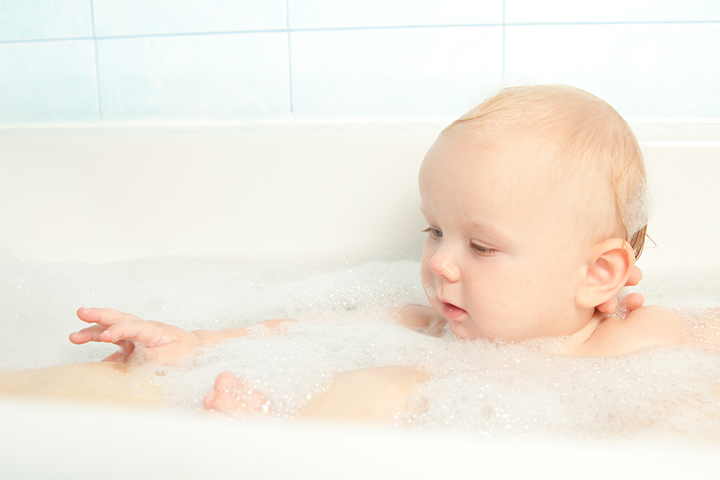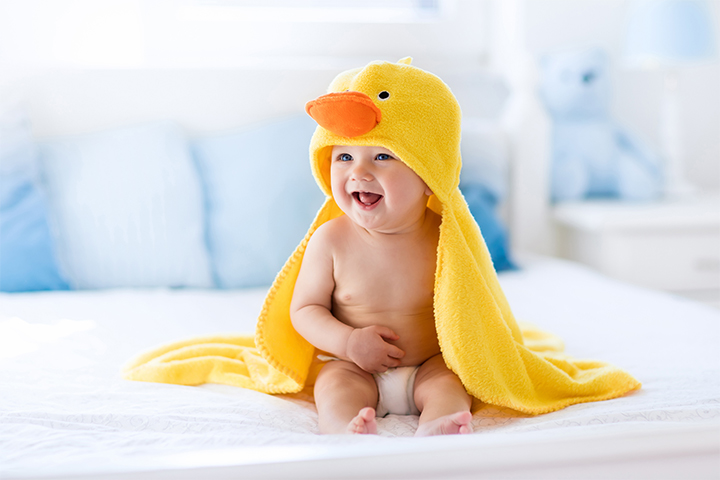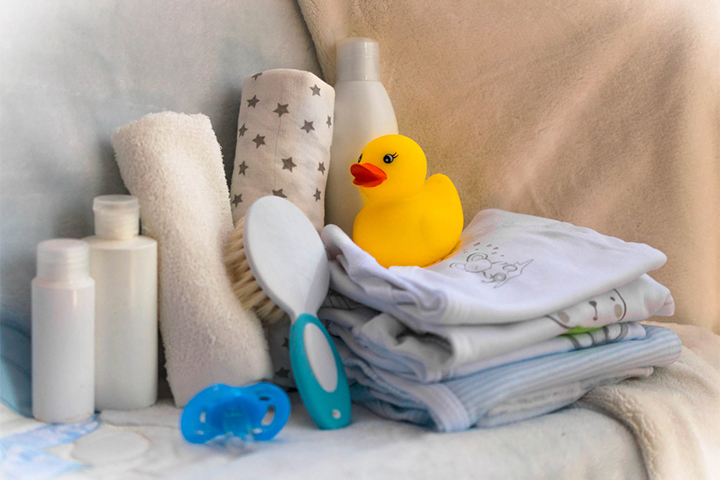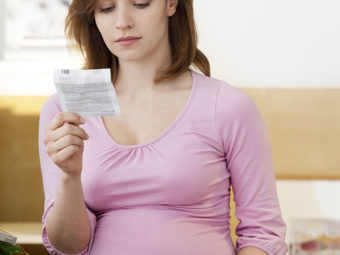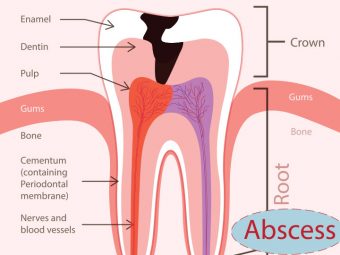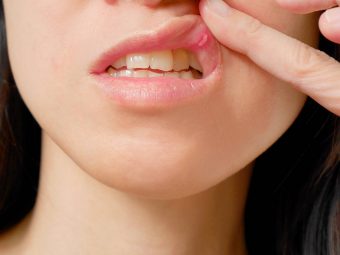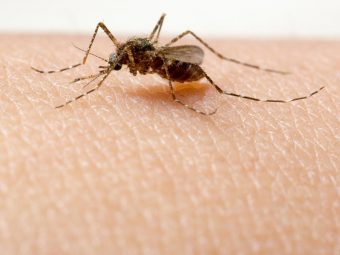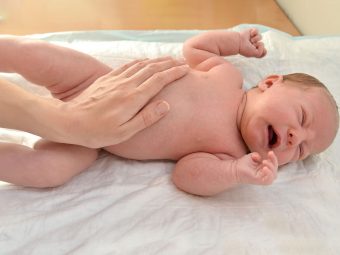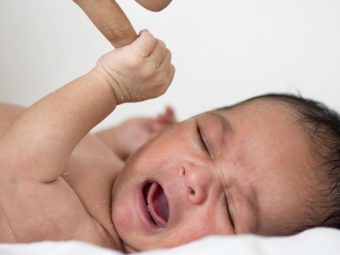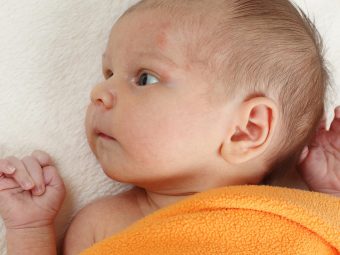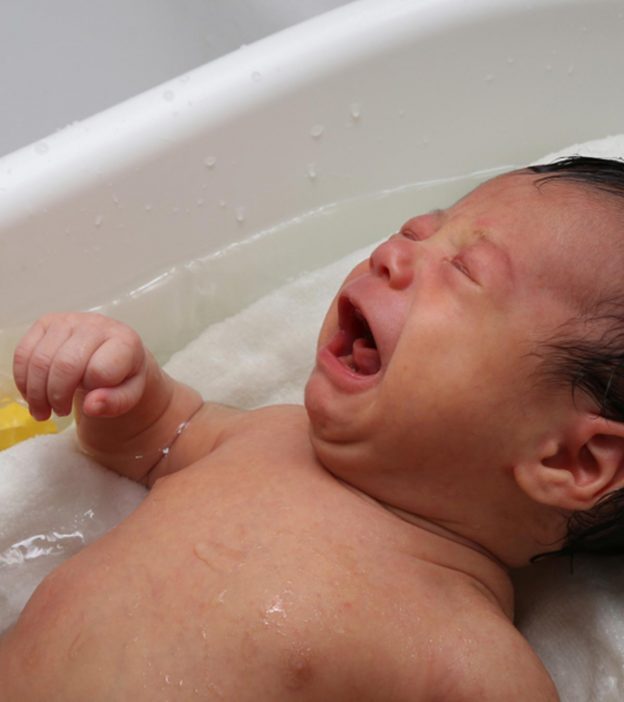
Image: shutterstock
Babies may have their first bath 24 hours after their birth. While most babies become used to bathing and enjoy it, some may consistently dislike it to the point that their parents begin wondering why their baby hates baths.Switching to sponge baths can be a temporary solution, but eventually, you need to figure out how to get your baby used to baths.
There may be various reasons a baby hates taking baths. This post explains why some babies dislike taking a bath and how to make them feel comfortable while bathing.
Why Do Babies Cry During A Bath?
Below are some of the common reasons why a baby could go cranky while bathing(1)(2).
- Change in temperature:Placing the baby in a bathtub with cold water could startle them, causing them to cry and resist getting in the water.It is also not ideal for the baby’s body, which is still developing adequate body temperature regulation.
- Water or soap in the eyes:Placing the faucet close to the baby’s eyes or rubbing the soap close to the baby’s eyes could lead to discomfort.
Image: Shutterstock
- Uncomfortable bathtub:Some bathtubs may not have a comfortable base, making it difficult for the toddler or the baby to sit comfortably.
- Tiredness before bathing:If the baby is tired or exhausted before bath, they are likely to cry while bathing.
- Hunger:A hungry baby is a cranky baby, and bathing them could worsen the situation.A hungry baby is likely to continue crying even after the bath.
- Cooling off quickly:Bathing for too long or not covering the baby with a towel immediately after a bath could cause them to lose body heat quickly. It can make some babies cry soon after a bath.
- Skin problems:Some babies with skin issues, such as eczema, may find contact with water uncomfortable. In some cases, it is the skincare product causing discomfort rather than water.
 Quick fact
Quick factHow To Stop Babies From Hating A Bath?
Image: Shutterstock
Parents may check for the possible reasons behind the baby hating a bath. You may observe the surroundings during baths or check the time when your baby usually begins tocry while bathing. Identifying the underlying cause and addressing it usually helps make bathing a comfortable experience for the little one.
Below are some other essential points to prevent a baby’s crankiness during baths and to make it a safe experience for them(3)(4)(5).
1. Select the right time for bathing
Bathe the baby when they are well-rested and not hungry. It will help prevent any crankiness or discomfort due to fatigue or hunger. However, avoid bathing right after they have fed since it could make some babies uncomfortable. Instead, wait for at least 30 minutes after a feed to begin bathing.
2. Set the right bathroom temperature
It is ideal to pre-warm the bathroom by closing all the windows or ventilators before the baby’s bath. You may also place a heater in the bathroom to warm it before the baby’s bath. The bathroom’s ambient temperature should be warm and comfortable.
3.Choose the right bathtub and tub mat
Pick a baby bathtub that is ideal for your little one.Experts recommend a hard-plastic bathtub featuring contours that make it easy for the baby to sit in it.The bathtub’s interior texture should be ridged or have a pattern that prevents the baby from slipping into the water.
You may also pick a soft bathtub pad or mat that can provide insulation and make sitting in the bathtub comfortable for the baby. Remember, even if you select a bathtub or mat with maximum grip, you must never leave the baby alone and always support their back and neck with your hands and arms. You can use a baby bath thermometer to ensure that the water has adequate temperature.
 Quick tip
Quick tip4. Select the right skincare products
Image: IStock
Not all soaps and scrubs may be suitable for a child so pick the right soap for your little one’s skin. The American Academy of Pediatrics recommends mild soap with a neutral pH and without additives for the baby’s skin.You may use a mild shampoo with the same qualities for thebaby’s scalp.
Its better to use soaps sparingly to prevent the baby’s skin from becoming dry. Babies with skin conditions may require specialized skincare products. Speak to a pediatrician or pediatric dermatologist to learn the best soap and shampoo for your baby’s skin.
5. Maintain the right water temperature
Fill the bathtub with warm water. The water should not be hot, and you must check it with your elbow before placing the baby in it. The maximum temperature limit for babies’ bathwater is 120°F (48°C). However, thesafest temperatureis 98.60 to 100.40°F (37-38°C). Also, once you undress the baby, place them in the bathtub immediately to prevent them from feeling cold.
6. Use hands to clean the baby gently
Take the water from the tub in your hands and gently pour it over the baby’s body instead of using a faucet. While bathing, if some soap or water goes into your baby’s eyes, use a dry towel to wipe their face gently. Make sure you support the baby’s back and head while washing their torso.
7. Wash the baby’s head last
Rinse and clean the baby’s head at the end of the bathing session to prevent them from feeling cold quickly. Wet the baby’s scalp with water, apply the shampoo in your hands, andgently massagetheir scalp. Take water in your cusped hands and gently rinse off the shampoo. Make sure that soapy water doesn’t enter eyes, ears, mouth, or nose.
如果你的宝宝是过度被水或the soapy foam running down their face, you may use a baby bath cap, which can direct the water away from the baby’s eyes.
8. Keep the towel ready
Image: IStock
Wrap the baby’s torso and head with a towel the moment you take them out of the bathtub. It can keep the baby warm and prevent loss of heat. Use the towel to pat-dry the baby gently. You may use towels or bathing gowns specially designed to keep babies warm after a bath.
9. Stick to a routine
Select the time and days for bath and stick to it to establish a routine. It could be especially helpful for babies who cry during baths for no apparent reason since a bathing routine will help make things predictable for them.
10. Change the frequency of bathing the baby
Some babies may only cry when bathed often. It could be that you are bathing your baby more than needed. Bathing your baby thrice a week with a gap of two days between each bath is sufficient during the first year. Bathing the baby often may dry their skin and also vex the baby quickly.
If you wish to bathe the baby every day, you may keep the duration short and use soap only for three baths per week and use plain water for the remaining baths.
11. Consult a doctor if the baby continues to hate bathing
Image: Shutterstock
If your baby continues to detest baths or becomes excessively upset during or after it, speak to a pediatrician. If your baby has a skin issue, your baby’s doctor may recommend a specific bathing routine. Some babies with skin problems may even require very few baths a month. Discuss the bathing routine and any concerns related to hygiene with your doctor.
常见问题
1. How often should I bathe my baby?
Bathe your babies two or three times a week for the first 12 months after birth. You need not bathe them daily as it may dry the skin (2).
2. What happens if infants drink water while bathing?
Gulping a little water during a bath may not be a cause of concern for babies. While bathing, soap water may cause minor problems such as an upset stomach.
3.有适龄的玩具或活动吗that can help make bath time more enjoyable for a baby?
Yes,you may also involve the baby in activities like pouring water from a plastic cup or playing with a washcloth to keep them occupied and calmer. You may also interact with the baby by talking to them or singing rhymes to them(6).
4.Does a baby’s dislike for baths diminish over time?
Bathing can initially be uncomfortable for infants. However, with consistent and gentle exposure to bath time, most babies gradually adjust to it and even start enjoying it. Still, some babies may dislike baths. If your baby’s dislike for baths doesn’t improve or worsen over time, speak to your doctor to determine the precise cause.
知道为什么宝宝讨厌洗澡可以帮你说吧e the problem and make the bath time more enjoyable and relaxing. Changes in water temperature, soap or shampoo on the eyes, hunger, tiredness, and uncomfortable bathtubs can make a baby cry and hesitate to bathe. Skin lesions such as eczema can also cause discomfort in water. Bathing too long and not drying can also make them feel cold. You may choose baby products to bathe and give a gentle bath in lukewarm water. However, always ensure to dry your baby with clean clothes and apply moisturizers to prevent dryness.
Infographic: How To Make Bathtime Fun For Babies?
If it breaks your heart to hear your baby cry every time you place them in the tub for a bath, you can include some fun elements in your baby’s bath routine to stop them from hating it. Try the ideas from the infographic below and see which one calms your baby the most.

Illustration: Momjunction Design Team
Get high-quality PDF version by clicking below.
Download Infographic
Key Pointers
- Using cold water for bathing, rubbing soap close to the baby’s eyes, and keeping the baby in an uncomfortable bathtub could be reasons they dislike bathing.
- Locating the precise cause and addressing it can make the bathing experience comfortable for most babies.
- Ensuring babies are well-fed and rested, choosing the right bathtub, and sticking to routine are a few ways to make bathing-time likable for babies.
- Consult a pediatrician promptly if the baby continues to be upset during or after a bath.
References:
2. Dipesh Navsaria,Bathing Your Baby; American Academy of Pediatrics
3.Bathing an infant; U.S. National Library of Medicine
4.Bathing and Skin Care for the Newborn; University of Rochester
5.Infant Water Safety: Protect Your New Baby from Drowning; American Academy of Pediatrics
6.Bath time learning activities: 0-2 years; Raising Children Network




